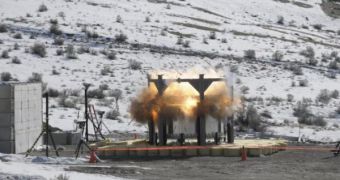Alliant Techsystems (ATK) successfully tested on Thursday the forward skirt extension separation test, which is crucial for NASA's ARES I-X mission, scheduled to take place sometime this year. The company has announced that its full-size test, which took place in Promontory, Utah, has been completely successful, and that the ensemble is ready to be used by the American space agency whenever the mission is scheduled to take off. For the moment, the date is unknown, as the original plan conflicts with that of the Hubble Space Telescope repair mission.
"The Ares I-X team is pleased with the completion of this key test that will provide important data leading up to the launch of the Ares I-X flight," Ares I-X test flight deputy mission manager Steve Davis, from NASA's Marshall Space Flight Center in Huntsville, Alabama, shares.
The separation process that was tested on Thursday is essential for the deployment of the three main parachutes of the test booster that will be launched from the Kennedy Space Center, in Florida. They are to be deployed at approximately 4,000 feet (roughly 1,400 meters), after the booster's descent is considerably slowed down by the drogue parachute.
"This was an important milestone for the program, as it validates key parameters to support the upcoming Ares I-X flight test. The program is one step closer to the flight test of Ares I-X," ATK Space Systems executive vice president Mike Kahn adds.
The forward skirt extension is to be detached from the rest of the rocket by a circular-shaped charge, which is why the researchers at ATK wanted to test the prototype in real-size, and not just in models or computer simulations. They have also measured the force of the blast, and the area that was affected, and have sent the data to NASA, for analysis and implementation into the ARES I-X mission estimates.
The whole ensemble also has to withstand the force it's subjected to once the main chutes engage. This shock is well known to sky divers who get pulled upwards very hard once they deploy their parachute. If these forces are not well calculated and accounted for, then the devices connecting the chutes to the boosters may come off, and the booster could be lost.

 14 DAY TRIAL //
14 DAY TRIAL //